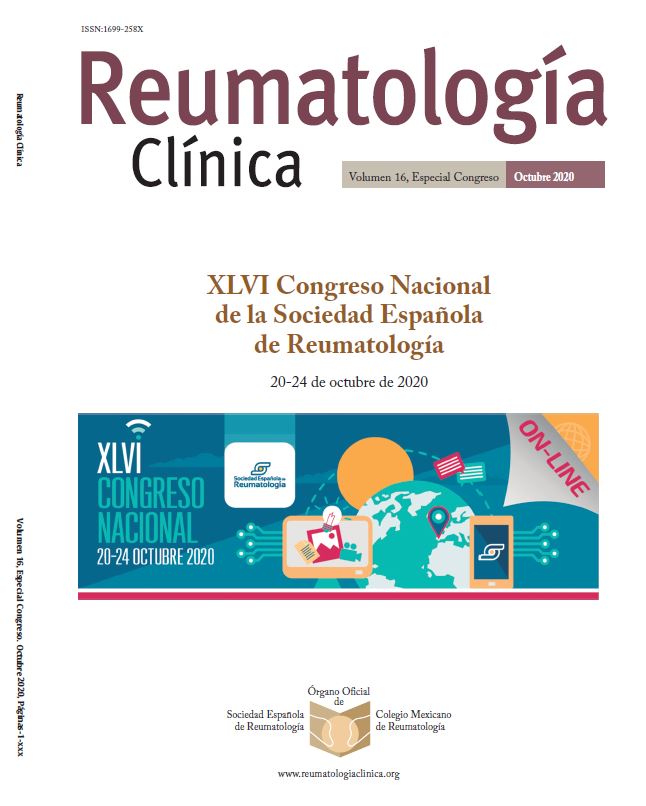CO41 - Radiographic progression in patients with axial spondyloarthritis under treatment with TNF inhibitors. Data from REGISPONSERBIO (Spanish Register of Biological Therapy in Spondyloarthritides)
1Hospital Universitari Parc Taulí. Sabadell. 2Hospital Universitario La Paz. Madrid. 3Hospital Universitario Reina Sofía/Instituto Maimonides de Investigación Biomédica de Córdoba (IMIBIC)/Universidad de Córdoba. 4Hospital Universitari Dr. Trueta. Girona. 5Hospital de la Arrixaca. Murcia. 6Hospital Universitario Doce de Octubre. Madrid. 7Hospital Univeristari de Bellvitge. Barcelona.
Introduction: Clinical efficacy of TNF inhibitors (TNFi) in axial spondyloarthritis (axSpA) has been widely probed in randomized control trials. In clinical practice, some studies suggested that long-term (more than 4 years) treatment with TNFi could slow down radiographic progression in axSpA; however, whether this treatment inhibits structural damage remains unclear.
Objectives: To evaluate radiographic progression in axSpA patients receiving long-term TNFi (over 4 years) in comparison with patients starting TNFi.
Methods: A total of 204 patients with axSpA were included in the Spanish Register of Biological Therapy in Spondyloarthritides (REGISPONSERBIO). Out of these, 80 patients (31 starting TNFi and 49 under long-term TNFi) were included in this study based on the availability of spinal radiographs (cervical and lumbar lateral views), at two time points. Radiographs in patients starting TNFi were available: i) at baseline (before TNFi) and ii) after 3 to 5 years of TNFi therapy (mean follow-up 3.7 ± 0.8), while in long-term TNFi patients, these were available: i) at one follow-up visit at least 4 years later since TNFi was started and ii) after 3 to 5 years of this visit (mean follow-up 3.5 ± 1.1). Two trained readers, not blinded for chronological order, independently scored lateral cervical and lumbar spine images according to the mSASSS system (0-72). Following definitions for progression were used: change of the absolute scores, change of ≥ 2 units, development of new syndesmophytes, and development of new syndesmophytes or growth of the existing syndesmophytes.
Results: Baseline characteristics of patients included in this study were similar to the total sample of REGISPONSERBIO. Reliability of both readers was excellent with intraclass correlation coefficients (ICCs) of 0.984 (0.976-0.990) at inclusion and 0.980 (0.968-0.987) at follow-up. Most patients (82.5%) were classified as radiographic axSpA. Mean BASDAI at first visit (i) was of 5.0 ± 2.4 for starting TNFi patients and of 3.2 ± 1.9 for long-term TNFi patients. The table depicted the results for radiographic scores and progression. No significant differences between both groups were observed. Mean mSASSS score at first visit (i) was 15.8 ± 21.5 and 15.1 ± 18.4 units for starting TNFi and long-term TNFi patients, respectively. The change score between both visits was 2.3 ± 4.2 and 2.3 ± 4.1 for starting TNFi and long-term TNFi patients, respectively. Similarly, no differences were found for change of ≥ 2 points (32.3% in starting TNFi and 35% in long-term TNFi patients). However, development of new syndesmophytes or growth of the existing syndesmophytes were found to be more frequently (but not significant) in starting TNFi patients compare to long-term TNFi patients.
|
Comparison of the starting TNFi and under long-term TNFi patients for the detection of radiographic progression in patients with axSpA (n = 80) |
|||
|
Starting TNFi patients |
Long-term TNFi patients* |
p-value |
|
|
Mean follow up 3,7 ± 0,8 years |
Mean follow up 3,5 ± 1,1 years |
||
|
Mean score at first visit, mean ± SD |
15.76 ± 21.50 |
15.05 ± 18.44 |
NS |
|
Mean score at follow up, mean ± SD |
18.08 ± 23.21 |
17.31 ± 19.83 |
NS |
|
Presence of syndesmophytes at first visit,% (n) |
45.2% (14) |
53.1% (26) |
NS |
|
Presence of syndesmophytes at follow up,% (n) |
51.6% (16) |
55.1% (27) |
NS |
|
Mean change score, mean ± SD |
2.32 ± 4.19 |
2.26 ± 4.09 |
NS |
|
Change of ≥ 2 units in the score% (n) |
32.3% (10) |
34.7% (17) |
NS |
|
Development of new syndesmophytes,% (n) |
29% (9) |
18.4% (9) |
0.3 |
|
Progression or development of new syndesmopyhtes% (n) |
29% (9) |
22.4% (11) |
0.5 |
|
*Patients with more than 4 years under TNFi treatment. |
|||
Conclusions: In patients with axSpA treated with TNFi in clinical practice radiographic progression is observed, independently of the time under this therapy. Nevertheless, the development and growth of syndesmophytes seem to be lower in long-term treated patients.






